Teenage Pregnancy: Exploring Risks, Support, and Methodologies
VerifiedAdded on 2023/01/04
|8
|2622
|45
Essay
AI Summary
This essay delves into the multifaceted issue of teenage pregnancy, examining its causes, consequences, and societal impact. It highlights the challenges faced by pregnant teenagers, including health complications, social stigma, and economic difficulties. The essay discusses the importance of social, family, and partner support in mitigating these challenges. It explores both the advantages and disadvantages of teenage pregnancy, considering various perspectives. Furthermore, it outlines the qualitative and quantitative methodologies employed in research related to this topic, discussing their respective strengths and weaknesses. The essay emphasizes the global nature of the problem, citing statistical data and highlighting the need for comprehensive support systems and societal understanding to address the complexities of teenage pregnancy effectively. The essay also discusses the impact of teenage pregnancy on poverty and social inclusion or exclusion.
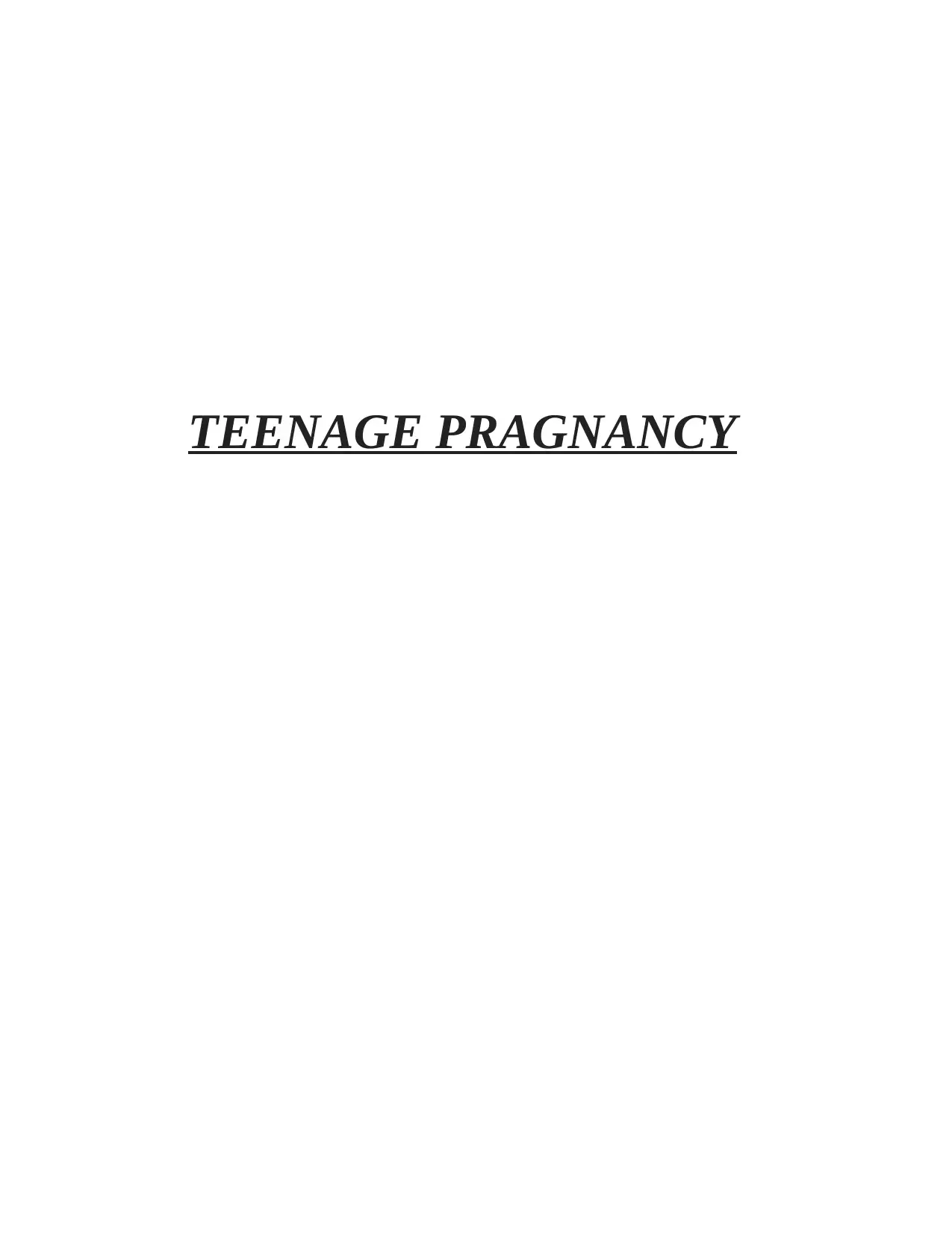
TEENAGE PRAGNANCY
Paraphrase This Document
Need a fresh take? Get an instant paraphrase of this document with our AI Paraphraser
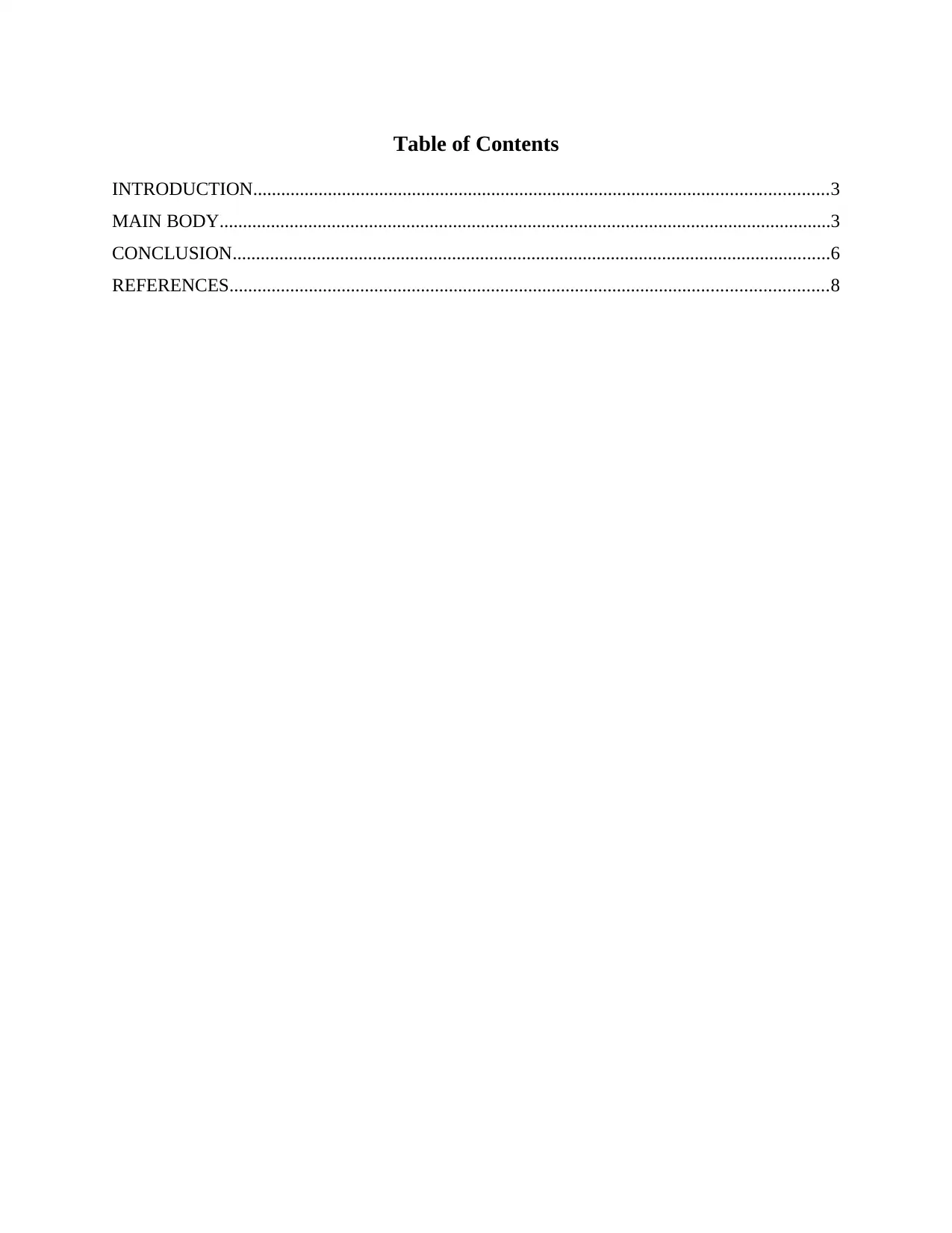
Table of Contents
INTRODUCTION...........................................................................................................................3
MAIN BODY...................................................................................................................................3
CONCLUSION................................................................................................................................6
REFERENCES................................................................................................................................8
INTRODUCTION...........................................................................................................................3
MAIN BODY...................................................................................................................................3
CONCLUSION................................................................................................................................6
REFERENCES................................................................................................................................8
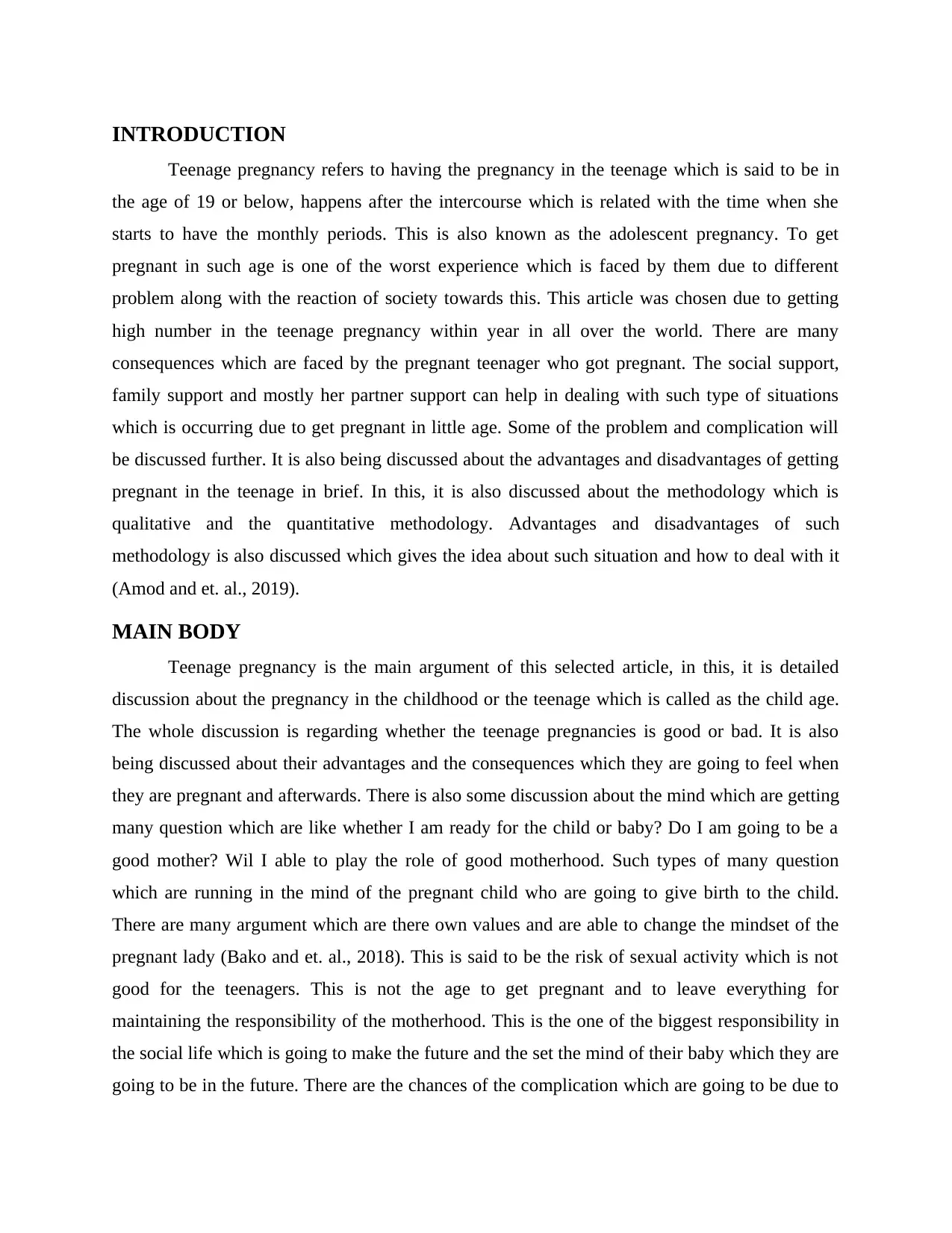
INTRODUCTION
Teenage pregnancy refers to having the pregnancy in the teenage which is said to be in
the age of 19 or below, happens after the intercourse which is related with the time when she
starts to have the monthly periods. This is also known as the adolescent pregnancy. To get
pregnant in such age is one of the worst experience which is faced by them due to different
problem along with the reaction of society towards this. This article was chosen due to getting
high number in the teenage pregnancy within year in all over the world. There are many
consequences which are faced by the pregnant teenager who got pregnant. The social support,
family support and mostly her partner support can help in dealing with such type of situations
which is occurring due to get pregnant in little age. Some of the problem and complication will
be discussed further. It is also being discussed about the advantages and disadvantages of getting
pregnant in the teenage in brief. In this, it is also discussed about the methodology which is
qualitative and the quantitative methodology. Advantages and disadvantages of such
methodology is also discussed which gives the idea about such situation and how to deal with it
(Amod and et. al., 2019).
MAIN BODY
Teenage pregnancy is the main argument of this selected article, in this, it is detailed
discussion about the pregnancy in the childhood or the teenage which is called as the child age.
The whole discussion is regarding whether the teenage pregnancies is good or bad. It is also
being discussed about their advantages and the consequences which they are going to feel when
they are pregnant and afterwards. There is also some discussion about the mind which are getting
many question which are like whether I am ready for the child or baby? Do I am going to be a
good mother? Wil I able to play the role of good motherhood. Such types of many question
which are running in the mind of the pregnant child who are going to give birth to the child.
There are many argument which are there own values and are able to change the mindset of the
pregnant lady (Bako and et. al., 2018). This is said to be the risk of sexual activity which is not
good for the teenagers. This is not the age to get pregnant and to leave everything for
maintaining the responsibility of the motherhood. This is the one of the biggest responsibility in
the social life which is going to make the future and the set the mind of their baby which they are
going to be in the future. There are the chances of the complication which are going to be due to
Teenage pregnancy refers to having the pregnancy in the teenage which is said to be in
the age of 19 or below, happens after the intercourse which is related with the time when she
starts to have the monthly periods. This is also known as the adolescent pregnancy. To get
pregnant in such age is one of the worst experience which is faced by them due to different
problem along with the reaction of society towards this. This article was chosen due to getting
high number in the teenage pregnancy within year in all over the world. There are many
consequences which are faced by the pregnant teenager who got pregnant. The social support,
family support and mostly her partner support can help in dealing with such type of situations
which is occurring due to get pregnant in little age. Some of the problem and complication will
be discussed further. It is also being discussed about the advantages and disadvantages of getting
pregnant in the teenage in brief. In this, it is also discussed about the methodology which is
qualitative and the quantitative methodology. Advantages and disadvantages of such
methodology is also discussed which gives the idea about such situation and how to deal with it
(Amod and et. al., 2019).
MAIN BODY
Teenage pregnancy is the main argument of this selected article, in this, it is detailed
discussion about the pregnancy in the childhood or the teenage which is called as the child age.
The whole discussion is regarding whether the teenage pregnancies is good or bad. It is also
being discussed about their advantages and the consequences which they are going to feel when
they are pregnant and afterwards. There is also some discussion about the mind which are getting
many question which are like whether I am ready for the child or baby? Do I am going to be a
good mother? Wil I able to play the role of good motherhood. Such types of many question
which are running in the mind of the pregnant child who are going to give birth to the child.
There are many argument which are there own values and are able to change the mindset of the
pregnant lady (Bako and et. al., 2018). This is said to be the risk of sexual activity which is not
good for the teenagers. This is not the age to get pregnant and to leave everything for
maintaining the responsibility of the motherhood. This is the one of the biggest responsibility in
the social life which is going to make the future and the set the mind of their baby which they are
going to be in the future. There are the chances of the complication which are going to be due to
⊘ This is a preview!⊘
Do you want full access?
Subscribe today to unlock all pages.

Trusted by 1+ million students worldwide
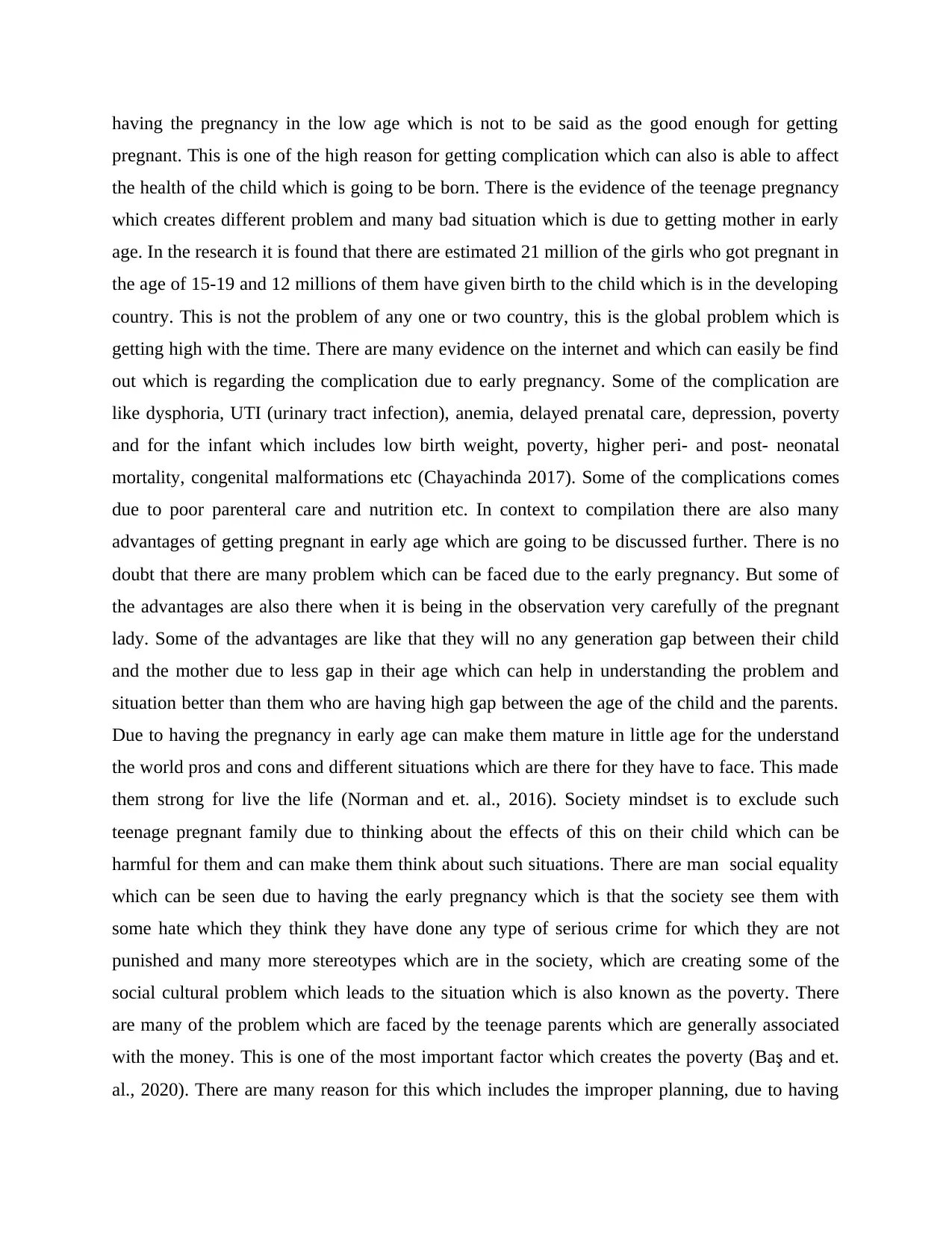
having the pregnancy in the low age which is not to be said as the good enough for getting
pregnant. This is one of the high reason for getting complication which can also is able to affect
the health of the child which is going to be born. There is the evidence of the teenage pregnancy
which creates different problem and many bad situation which is due to getting mother in early
age. In the research it is found that there are estimated 21 million of the girls who got pregnant in
the age of 15-19 and 12 millions of them have given birth to the child which is in the developing
country. This is not the problem of any one or two country, this is the global problem which is
getting high with the time. There are many evidence on the internet and which can easily be find
out which is regarding the complication due to early pregnancy. Some of the complication are
like dysphoria, UTI (urinary tract infection), anemia, delayed prenatal care, depression, poverty
and for the infant which includes low birth weight, poverty, higher peri- and post- neonatal
mortality, congenital malformations etc (Chayachinda 2017). Some of the complications comes
due to poor parenteral care and nutrition etc. In context to compilation there are also many
advantages of getting pregnant in early age which are going to be discussed further. There is no
doubt that there are many problem which can be faced due to the early pregnancy. But some of
the advantages are also there when it is being in the observation very carefully of the pregnant
lady. Some of the advantages are like that they will no any generation gap between their child
and the mother due to less gap in their age which can help in understanding the problem and
situation better than them who are having high gap between the age of the child and the parents.
Due to having the pregnancy in early age can make them mature in little age for the understand
the world pros and cons and different situations which are there for they have to face. This made
them strong for live the life (Norman and et. al., 2016). Society mindset is to exclude such
teenage pregnant family due to thinking about the effects of this on their child which can be
harmful for them and can make them think about such situations. There are man social equality
which can be seen due to having the early pregnancy which is that the society see them with
some hate which they think they have done any type of serious crime for which they are not
punished and many more stereotypes which are in the society, which are creating some of the
social cultural problem which leads to the situation which is also known as the poverty. There
are many of the problem which are faced by the teenage parents which are generally associated
with the money. This is one of the most important factor which creates the poverty (Baş and et.
al., 2020). There are many reason for this which includes the improper planning, due to having
pregnant. This is one of the high reason for getting complication which can also is able to affect
the health of the child which is going to be born. There is the evidence of the teenage pregnancy
which creates different problem and many bad situation which is due to getting mother in early
age. In the research it is found that there are estimated 21 million of the girls who got pregnant in
the age of 15-19 and 12 millions of them have given birth to the child which is in the developing
country. This is not the problem of any one or two country, this is the global problem which is
getting high with the time. There are many evidence on the internet and which can easily be find
out which is regarding the complication due to early pregnancy. Some of the complication are
like dysphoria, UTI (urinary tract infection), anemia, delayed prenatal care, depression, poverty
and for the infant which includes low birth weight, poverty, higher peri- and post- neonatal
mortality, congenital malformations etc (Chayachinda 2017). Some of the complications comes
due to poor parenteral care and nutrition etc. In context to compilation there are also many
advantages of getting pregnant in early age which are going to be discussed further. There is no
doubt that there are many problem which can be faced due to the early pregnancy. But some of
the advantages are also there when it is being in the observation very carefully of the pregnant
lady. Some of the advantages are like that they will no any generation gap between their child
and the mother due to less gap in their age which can help in understanding the problem and
situation better than them who are having high gap between the age of the child and the parents.
Due to having the pregnancy in early age can make them mature in little age for the understand
the world pros and cons and different situations which are there for they have to face. This made
them strong for live the life (Norman and et. al., 2016). Society mindset is to exclude such
teenage pregnant family due to thinking about the effects of this on their child which can be
harmful for them and can make them think about such situations. There are man social equality
which can be seen due to having the early pregnancy which is that the society see them with
some hate which they think they have done any type of serious crime for which they are not
punished and many more stereotypes which are in the society, which are creating some of the
social cultural problem which leads to the situation which is also known as the poverty. There
are many of the problem which are faced by the teenage parents which are generally associated
with the money. This is one of the most important factor which creates the poverty (Baş and et.
al., 2020). There are many reason for this which includes the improper planning, due to having
Paraphrase This Document
Need a fresh take? Get an instant paraphrase of this document with our AI Paraphraser
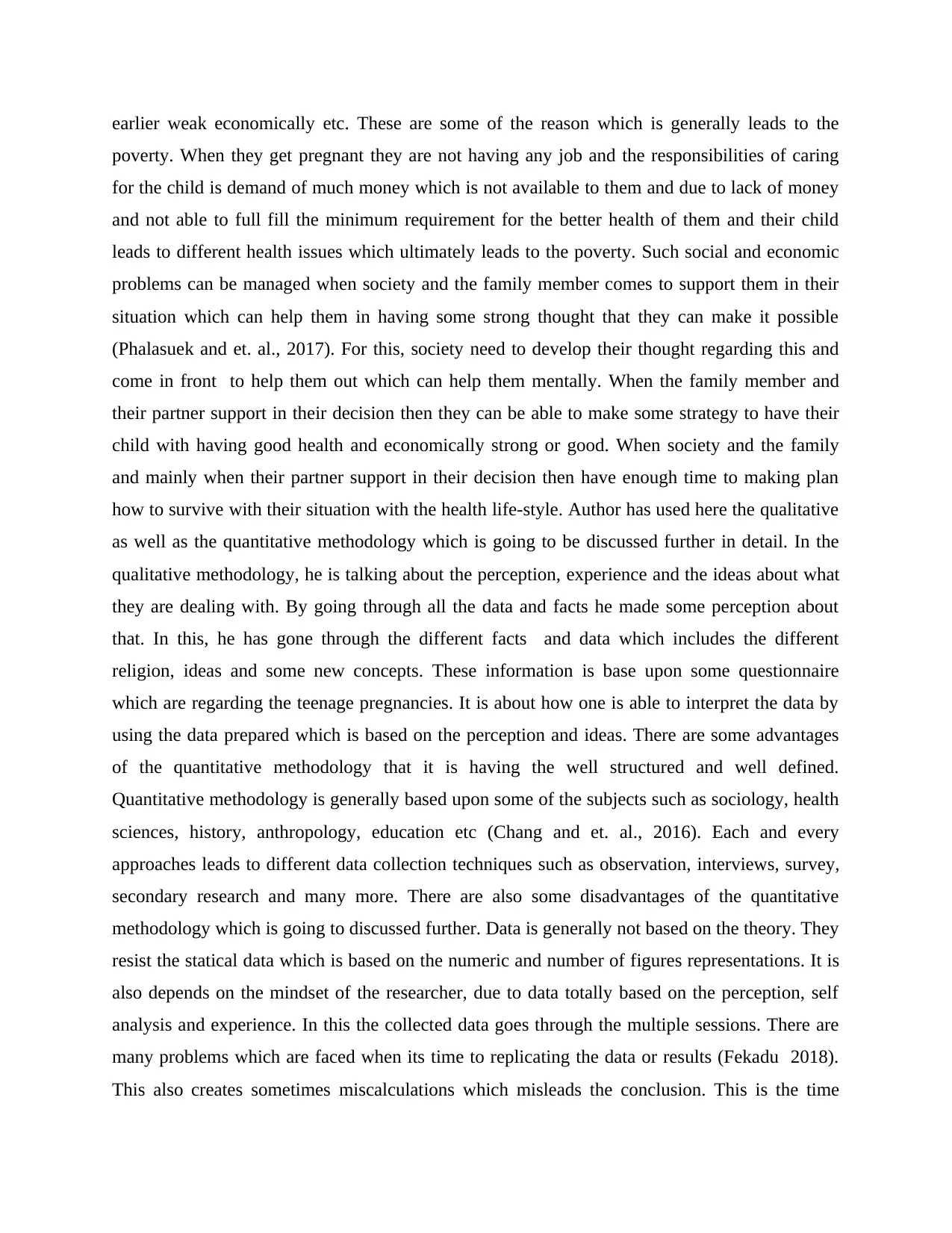
earlier weak economically etc. These are some of the reason which is generally leads to the
poverty. When they get pregnant they are not having any job and the responsibilities of caring
for the child is demand of much money which is not available to them and due to lack of money
and not able to full fill the minimum requirement for the better health of them and their child
leads to different health issues which ultimately leads to the poverty. Such social and economic
problems can be managed when society and the family member comes to support them in their
situation which can help them in having some strong thought that they can make it possible
(Phalasuek and et. al., 2017). For this, society need to develop their thought regarding this and
come in front to help them out which can help them mentally. When the family member and
their partner support in their decision then they can be able to make some strategy to have their
child with having good health and economically strong or good. When society and the family
and mainly when their partner support in their decision then have enough time to making plan
how to survive with their situation with the health life-style. Author has used here the qualitative
as well as the quantitative methodology which is going to be discussed further in detail. In the
qualitative methodology, he is talking about the perception, experience and the ideas about what
they are dealing with. By going through all the data and facts he made some perception about
that. In this, he has gone through the different facts and data which includes the different
religion, ideas and some new concepts. These information is base upon some questionnaire
which are regarding the teenage pregnancies. It is about how one is able to interpret the data by
using the data prepared which is based on the perception and ideas. There are some advantages
of the quantitative methodology that it is having the well structured and well defined.
Quantitative methodology is generally based upon some of the subjects such as sociology, health
sciences, history, anthropology, education etc (Chang and et. al., 2016). Each and every
approaches leads to different data collection techniques such as observation, interviews, survey,
secondary research and many more. There are also some disadvantages of the quantitative
methodology which is going to discussed further. Data is generally not based on the theory. They
resist the statical data which is based on the numeric and number of figures representations. It is
also depends on the mindset of the researcher, due to data totally based on the perception, self
analysis and experience. In this the collected data goes through the multiple sessions. There are
many problems which are faced when its time to replicating the data or results (Fekadu 2018).
This also creates sometimes miscalculations which misleads the conclusion. This is the time
poverty. When they get pregnant they are not having any job and the responsibilities of caring
for the child is demand of much money which is not available to them and due to lack of money
and not able to full fill the minimum requirement for the better health of them and their child
leads to different health issues which ultimately leads to the poverty. Such social and economic
problems can be managed when society and the family member comes to support them in their
situation which can help them in having some strong thought that they can make it possible
(Phalasuek and et. al., 2017). For this, society need to develop their thought regarding this and
come in front to help them out which can help them mentally. When the family member and
their partner support in their decision then they can be able to make some strategy to have their
child with having good health and economically strong or good. When society and the family
and mainly when their partner support in their decision then have enough time to making plan
how to survive with their situation with the health life-style. Author has used here the qualitative
as well as the quantitative methodology which is going to be discussed further in detail. In the
qualitative methodology, he is talking about the perception, experience and the ideas about what
they are dealing with. By going through all the data and facts he made some perception about
that. In this, he has gone through the different facts and data which includes the different
religion, ideas and some new concepts. These information is base upon some questionnaire
which are regarding the teenage pregnancies. It is about how one is able to interpret the data by
using the data prepared which is based on the perception and ideas. There are some advantages
of the quantitative methodology that it is having the well structured and well defined.
Quantitative methodology is generally based upon some of the subjects such as sociology, health
sciences, history, anthropology, education etc (Chang and et. al., 2016). Each and every
approaches leads to different data collection techniques such as observation, interviews, survey,
secondary research and many more. There are also some disadvantages of the quantitative
methodology which is going to discussed further. Data is generally not based on the theory. They
resist the statical data which is based on the numeric and number of figures representations. It is
also depends on the mindset of the researcher, due to data totally based on the perception, self
analysis and experience. In this the collected data goes through the multiple sessions. There are
many problems which are faced when its time to replicating the data or results (Fekadu 2018).
This also creates sometimes miscalculations which misleads the conclusion. This is the time
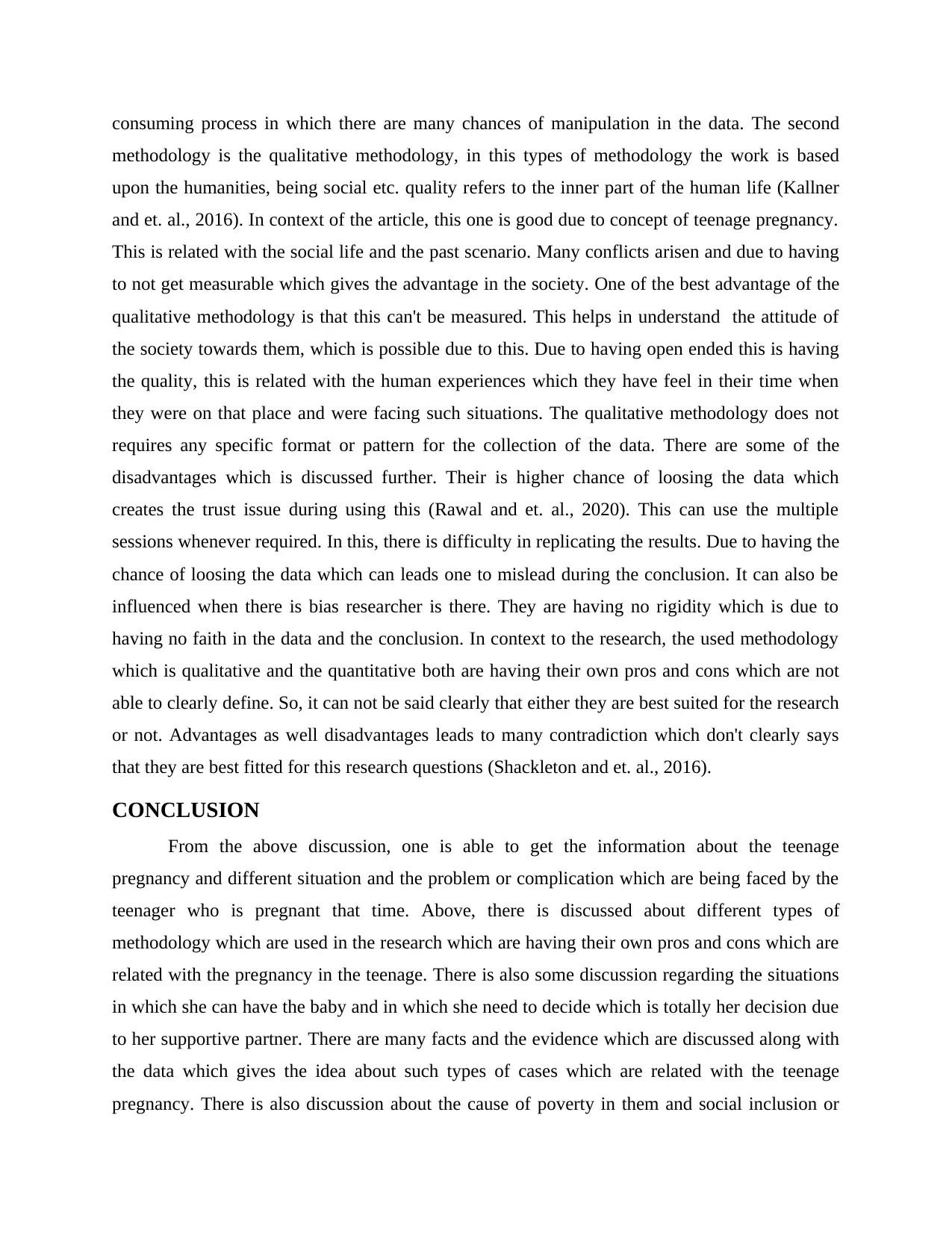
consuming process in which there are many chances of manipulation in the data. The second
methodology is the qualitative methodology, in this types of methodology the work is based
upon the humanities, being social etc. quality refers to the inner part of the human life (Kallner
and et. al., 2016). In context of the article, this one is good due to concept of teenage pregnancy.
This is related with the social life and the past scenario. Many conflicts arisen and due to having
to not get measurable which gives the advantage in the society. One of the best advantage of the
qualitative methodology is that this can't be measured. This helps in understand the attitude of
the society towards them, which is possible due to this. Due to having open ended this is having
the quality, this is related with the human experiences which they have feel in their time when
they were on that place and were facing such situations. The qualitative methodology does not
requires any specific format or pattern for the collection of the data. There are some of the
disadvantages which is discussed further. Their is higher chance of loosing the data which
creates the trust issue during using this (Rawal and et. al., 2020). This can use the multiple
sessions whenever required. In this, there is difficulty in replicating the results. Due to having the
chance of loosing the data which can leads one to mislead during the conclusion. It can also be
influenced when there is bias researcher is there. They are having no rigidity which is due to
having no faith in the data and the conclusion. In context to the research, the used methodology
which is qualitative and the quantitative both are having their own pros and cons which are not
able to clearly define. So, it can not be said clearly that either they are best suited for the research
or not. Advantages as well disadvantages leads to many contradiction which don't clearly says
that they are best fitted for this research questions (Shackleton and et. al., 2016).
CONCLUSION
From the above discussion, one is able to get the information about the teenage
pregnancy and different situation and the problem or complication which are being faced by the
teenager who is pregnant that time. Above, there is discussed about different types of
methodology which are used in the research which are having their own pros and cons which are
related with the pregnancy in the teenage. There is also some discussion regarding the situations
in which she can have the baby and in which she need to decide which is totally her decision due
to her supportive partner. There are many facts and the evidence which are discussed along with
the data which gives the idea about such types of cases which are related with the teenage
pregnancy. There is also discussion about the cause of poverty in them and social inclusion or
methodology is the qualitative methodology, in this types of methodology the work is based
upon the humanities, being social etc. quality refers to the inner part of the human life (Kallner
and et. al., 2016). In context of the article, this one is good due to concept of teenage pregnancy.
This is related with the social life and the past scenario. Many conflicts arisen and due to having
to not get measurable which gives the advantage in the society. One of the best advantage of the
qualitative methodology is that this can't be measured. This helps in understand the attitude of
the society towards them, which is possible due to this. Due to having open ended this is having
the quality, this is related with the human experiences which they have feel in their time when
they were on that place and were facing such situations. The qualitative methodology does not
requires any specific format or pattern for the collection of the data. There are some of the
disadvantages which is discussed further. Their is higher chance of loosing the data which
creates the trust issue during using this (Rawal and et. al., 2020). This can use the multiple
sessions whenever required. In this, there is difficulty in replicating the results. Due to having the
chance of loosing the data which can leads one to mislead during the conclusion. It can also be
influenced when there is bias researcher is there. They are having no rigidity which is due to
having no faith in the data and the conclusion. In context to the research, the used methodology
which is qualitative and the quantitative both are having their own pros and cons which are not
able to clearly define. So, it can not be said clearly that either they are best suited for the research
or not. Advantages as well disadvantages leads to many contradiction which don't clearly says
that they are best fitted for this research questions (Shackleton and et. al., 2016).
CONCLUSION
From the above discussion, one is able to get the information about the teenage
pregnancy and different situation and the problem or complication which are being faced by the
teenager who is pregnant that time. Above, there is discussed about different types of
methodology which are used in the research which are having their own pros and cons which are
related with the pregnancy in the teenage. There is also some discussion regarding the situations
in which she can have the baby and in which she need to decide which is totally her decision due
to her supportive partner. There are many facts and the evidence which are discussed along with
the data which gives the idea about such types of cases which are related with the teenage
pregnancy. There is also discussion about the cause of poverty in them and social inclusion or
⊘ This is a preview!⊘
Do you want full access?
Subscribe today to unlock all pages.

Trusted by 1+ million students worldwide

exclusion which is related with the society. Risk of birth, it's complication and which type of
support she needs to have the baby is explained here. There are some gaps which are need to
filled out in this research which will be base for the future research. Whatever the decision for
the birth, family, her partner and society needs to support her for any decision.
support she needs to have the baby is explained here. There are some gaps which are need to
filled out in this research which will be base for the future research. Whatever the decision for
the birth, family, her partner and society needs to support her for any decision.
Paraphrase This Document
Need a fresh take? Get an instant paraphrase of this document with our AI Paraphraser
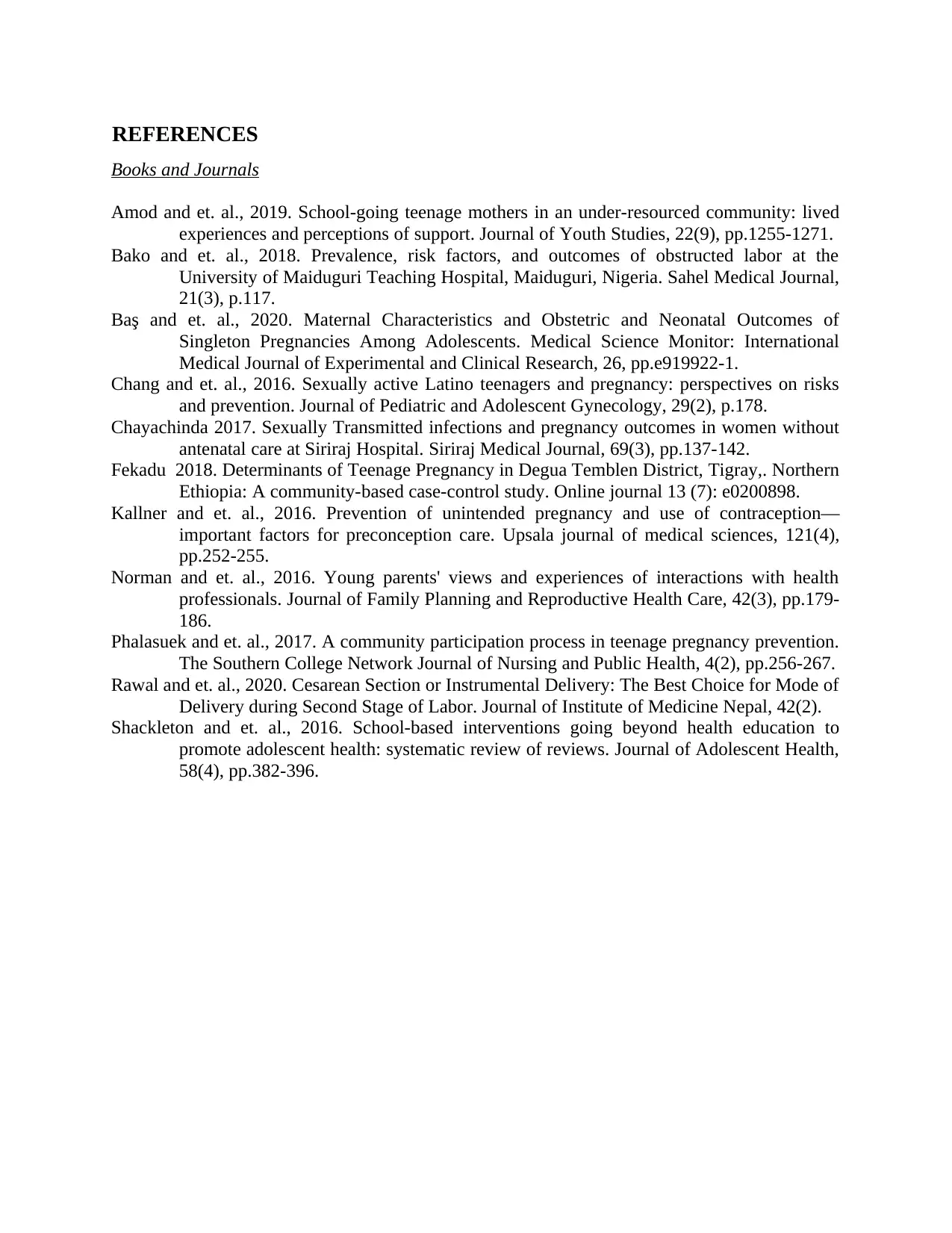
REFERENCES
Books and Journals
Amod and et. al., 2019. School-going teenage mothers in an under-resourced community: lived
experiences and perceptions of support. Journal of Youth Studies, 22(9), pp.1255-1271.
Bako and et. al., 2018. Prevalence, risk factors, and outcomes of obstructed labor at the
University of Maiduguri Teaching Hospital, Maiduguri, Nigeria. Sahel Medical Journal,
21(3), p.117.
Baş and et. al., 2020. Maternal Characteristics and Obstetric and Neonatal Outcomes of
Singleton Pregnancies Among Adolescents. Medical Science Monitor: International
Medical Journal of Experimental and Clinical Research, 26, pp.e919922-1.
Chang and et. al., 2016. Sexually active Latino teenagers and pregnancy: perspectives on risks
and prevention. Journal of Pediatric and Adolescent Gynecology, 29(2), p.178.
Chayachinda 2017. Sexually Transmitted infections and pregnancy outcomes in women without
antenatal care at Siriraj Hospital. Siriraj Medical Journal, 69(3), pp.137-142.
Fekadu 2018. Determinants of Teenage Pregnancy in Degua Temblen District, Tigray,. Northern
Ethiopia: A community-based case-control study. Online journal 13 (7): e0200898.
Kallner and et. al., 2016. Prevention of unintended pregnancy and use of contraception—
important factors for preconception care. Upsala journal of medical sciences, 121(4),
pp.252-255.
Norman and et. al., 2016. Young parents' views and experiences of interactions with health
professionals. Journal of Family Planning and Reproductive Health Care, 42(3), pp.179-
186.
Phalasuek and et. al., 2017. A community participation process in teenage pregnancy prevention.
The Southern College Network Journal of Nursing and Public Health, 4(2), pp.256-267.
Rawal and et. al., 2020. Cesarean Section or Instrumental Delivery: The Best Choice for Mode of
Delivery during Second Stage of Labor. Journal of Institute of Medicine Nepal, 42(2).
Shackleton and et. al., 2016. School-based interventions going beyond health education to
promote adolescent health: systematic review of reviews. Journal of Adolescent Health,
58(4), pp.382-396.
Books and Journals
Amod and et. al., 2019. School-going teenage mothers in an under-resourced community: lived
experiences and perceptions of support. Journal of Youth Studies, 22(9), pp.1255-1271.
Bako and et. al., 2018. Prevalence, risk factors, and outcomes of obstructed labor at the
University of Maiduguri Teaching Hospital, Maiduguri, Nigeria. Sahel Medical Journal,
21(3), p.117.
Baş and et. al., 2020. Maternal Characteristics and Obstetric and Neonatal Outcomes of
Singleton Pregnancies Among Adolescents. Medical Science Monitor: International
Medical Journal of Experimental and Clinical Research, 26, pp.e919922-1.
Chang and et. al., 2016. Sexually active Latino teenagers and pregnancy: perspectives on risks
and prevention. Journal of Pediatric and Adolescent Gynecology, 29(2), p.178.
Chayachinda 2017. Sexually Transmitted infections and pregnancy outcomes in women without
antenatal care at Siriraj Hospital. Siriraj Medical Journal, 69(3), pp.137-142.
Fekadu 2018. Determinants of Teenage Pregnancy in Degua Temblen District, Tigray,. Northern
Ethiopia: A community-based case-control study. Online journal 13 (7): e0200898.
Kallner and et. al., 2016. Prevention of unintended pregnancy and use of contraception—
important factors for preconception care. Upsala journal of medical sciences, 121(4),
pp.252-255.
Norman and et. al., 2016. Young parents' views and experiences of interactions with health
professionals. Journal of Family Planning and Reproductive Health Care, 42(3), pp.179-
186.
Phalasuek and et. al., 2017. A community participation process in teenage pregnancy prevention.
The Southern College Network Journal of Nursing and Public Health, 4(2), pp.256-267.
Rawal and et. al., 2020. Cesarean Section or Instrumental Delivery: The Best Choice for Mode of
Delivery during Second Stage of Labor. Journal of Institute of Medicine Nepal, 42(2).
Shackleton and et. al., 2016. School-based interventions going beyond health education to
promote adolescent health: systematic review of reviews. Journal of Adolescent Health,
58(4), pp.382-396.
1 out of 8
Related Documents
Your All-in-One AI-Powered Toolkit for Academic Success.
+13062052269
info@desklib.com
Available 24*7 on WhatsApp / Email
![[object Object]](/_next/static/media/star-bottom.7253800d.svg)
Unlock your academic potential
Copyright © 2020–2025 A2Z Services. All Rights Reserved. Developed and managed by ZUCOL.





